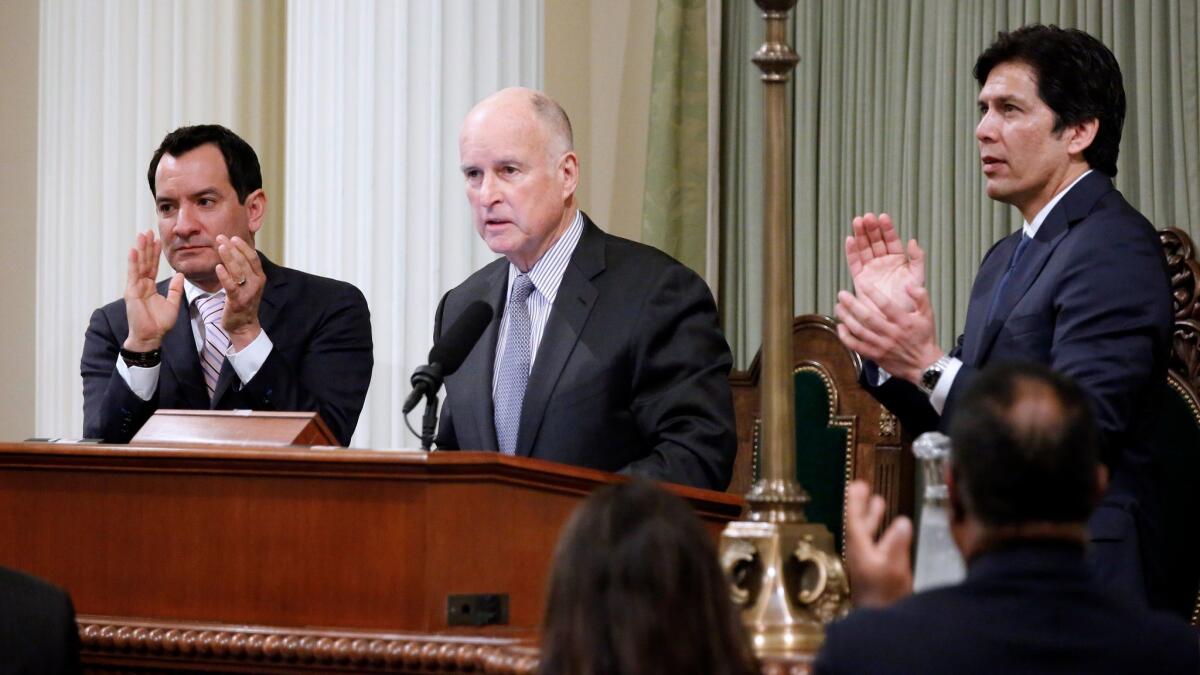Column: California’s state budget negotiations in 2018 might be less about what to spend than when to spend it

Few outside of Sacramento realize that some of the most important state budget decisions happen just before Christmas, in private meetings where the governor signs off on the spending plan he will present to the Legislature in early January.
While we don’t know what Gov. Jerry Brown has decided, here’s a safe bet about the budget debate of 2018: It will be resolved in some measure by spending agreements that are less about “if” and more about “when.”
Key to that, of course, is money. Last month, the independent Legislative Analyst’s Office estimated that tax collections will soar past official projections by $7.5 billion in the budget year that begins next July. That gives lawmakers a wide range of options.
The process for divvying up cash is where the deal-making happens. And in the five years since the last budget deficits, there have been some clear signs that lawmakers have started to look beyond the next 12 months.
First, they crafted a 2014 constitutional amendment that expanded the state’s rainy-day reserve, now expected to total $8.5 billion by next summer. That same law also requires estimates for revenues and expenses three years into the future. Critics may still believe the state spends too much, but budget negotiations now routinely involve a look at what’s over the horizon. That wasn’t always the case over the last decade.
Gov. Jerry Brown’s wall of debt has crumbled, but more walls remain unbroken »
Closely tied to that longer view is the increased use of flexible spending. Often, that provides a way to embrace a big policy goal without an immediate and equally big price tag. Take this past summer’s budget deal that included dental coverage for those enrolled in the state’s Medi-Cal program and an expansion of subsidized child care. Both changes take effect on Jan. 1, which means they were only scored at a six-month cost in the current fiscal year. Delay the implementation and you spend less in the short run.
There also are what budget writers call “off-ramps” built into some of the most pricey policy efforts, like the 2016 deal between Brown and labor groups to raise California’s minimum wage to $15 an hour by 2022. If economic conditions deteriorate and money gets tight, the law says the governor can pause some of those future increases.
Most of California’s $55-billion in tax breaks are here to stay »
This may sound like old-fashioned common sense, but California budget fights in the past often felt like a bitter binary choice: You either funded a program or you didn’t. The emergence of a more flexible, gradual approach to state government spending has helped lower the political temperature in Sacramento. It has been an integral component to negotiations between Brown and legislative Democrats.
It’s also how Assembly Budget Chairman Phil Ting (D-San Francisco) was able to roll out what looked like an awfully ambitious list of budget priorities last week, even after he embraced using some $3 billion of the projected windfall for an extra payment to the rainy-day fund. On the spending side, Democrats are calling for expanding the state’s earned-income tax credit for the working poor. Ting also urged restoration of cost-of-living increases for the aged, blind and disabled. And he said the state could afford to spend more on California’s middle-class scholarship program. Democrats also have hopes to fully implement a new law offering first-time students a free year of community college.
To do all of that, the spending would probably have to kick in over a couple of budgets. Sure, at some point there still has to be enough money to pay the full freight. But the 2018 budget debate in the state Capitol could very well line up with one of life’s greatest lessons: Timing is everything.
Follow @johnmyers on Twitter, sign up for our daily Essential Politics newsletter and listen to the weekly California Politics Podcast
More to Read
Get the L.A. Times Politics newsletter
Deeply reported insights into legislation, politics and policy from Sacramento, Washington and beyond. In your inbox three times per week.
You may occasionally receive promotional content from the Los Angeles Times.







